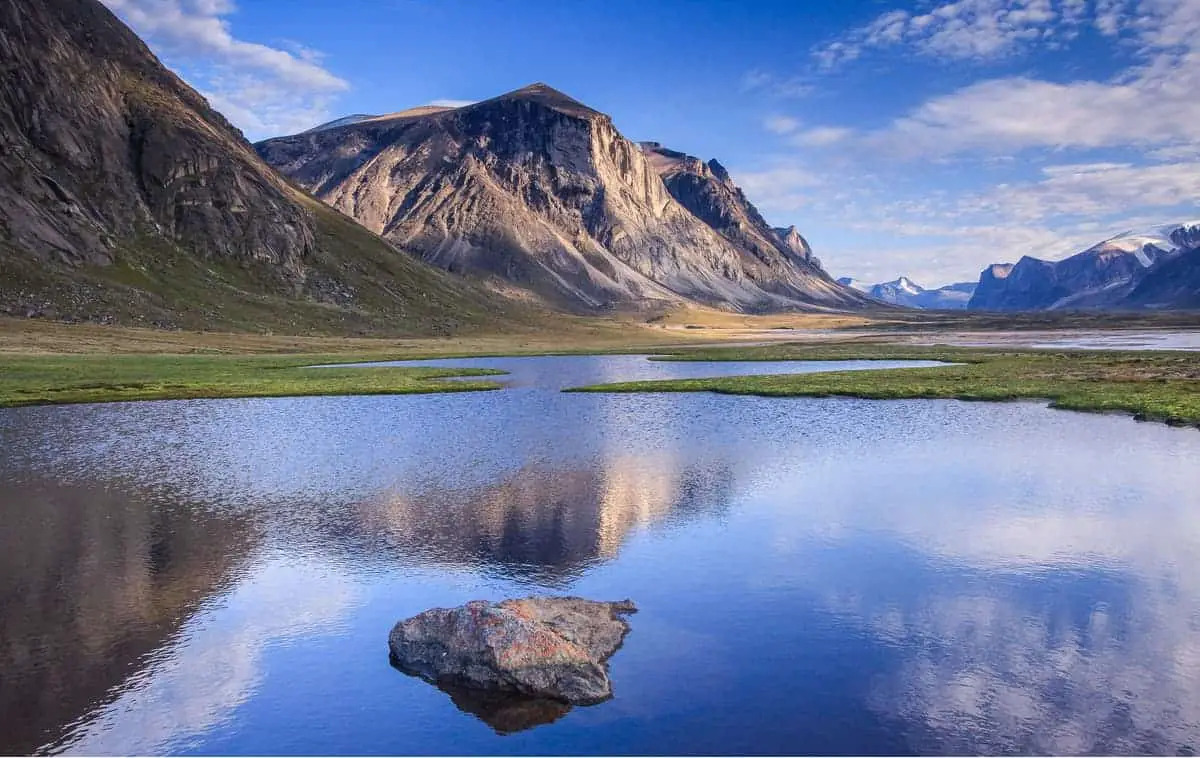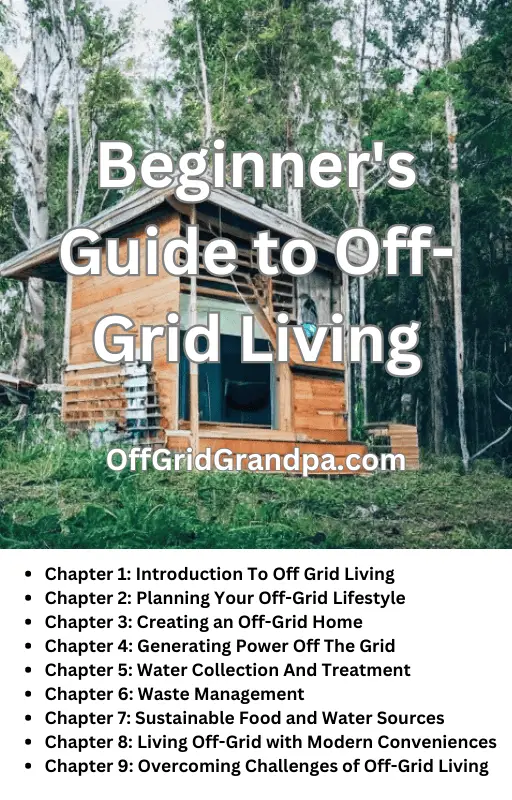Nunavut is located on the northern coast of Canada, it is probably one of the most beautiful provinces in the country and one of the coldest ones. When you first arrive at Nunavut you will feel like you are on another planet, especially in the northern regions of this province. Although living off the grid here is possible, it is a completely different way of off grid living than in the southern provinces.
Nunavut is not a good option for off grid living, the local climate is way too harsh, in most of the province you won’t be able to grow anything and the cost of living is so high that you might as well move to Hawaii. People who live off the grid in Nunavut mostly live off the land, they are skilled hunters and fishermen and most of them do not even bother generating power.
If you want to live off the grid in Nunavut then you will need a reliable bear spray, my personal recommendation is to use one that is effective against all types of bears Click here to check it out on Amazon.com
Nunavut has a lot of Inuit communities, and most of them do live off the grid although some of them use modern technology like snowmobiles. In the northern parts of the province, you will see fewer and fewer people using snowmobiles and more dog sleds. The main reason is that getting fuel into some areas is not economically viable, as the costs of transporting anything in these areas are expensive.
In the northern parts of the province, there are a lot of areas owned by the Inuits like Kugluktuk, Bathurst, Gjoa, Coral Harbour, Repulse Bay, Hall Beach, and Grise Fiord. Nunavut is one of the largest provinces in Canada and with one of the lowest population densities. Currently, there are around 39k people living here and the population has started to steadily grow in the past couple of years.
The biggest city in this province is Iqaluit with around 7k population, followed by Rankin Inlet with 2800, Arviat with 2600, Baker Lake with 2000, Cambridge Bay with 1700, and Igloolik with around 1600 residents. One of the problems with Nunavut is that it has a high cost of living, although there is a big demand for skilled workers like doctors and nurses who tend to make a lot more money than in the southern parts of the country. If you want to take a look at Nunavut’s western neighbor then check out my recent article Off grid living in the Northwest Territories ( Canada’s Last Frontier ).
Is Off Grid Living Legal In Nunavut?
Off-grid living is generally legal in Nunavut. However, there may be specific regulations and requirements related to land use, construction, and environmental considerations that individuals need to comply with when living off-grid in the territory. It is important to consult with local authorities and obtain any necessary permits or permissions.
Off Grid Laws
Living off the grid in Nunavut is legal, just do not expect off grid living to be even remotely similar to the southern provinces or in the states. Most cities and towns do have some educational programs although you will most likely homeschool your children, https://www.gov.nu.ca/sites/default/files/homeschooling_reimbursements_directive.pdf.
Generating Power Off The Grid
- Solar power: Some communities and individual households generate all of their power with solar panels, although all of them have at least one backup. If you are planning to generate most of your power with solar panels in this province then you will have to make some careful calculations during the wintertime as the days are fairly short. This province doesn’t have any incentive for solar power although you can still apply for the Capital Cost Allowance (CCA) Renewable Energy.
- Wind power: Nunavut isn’t the best place to generate power with wind turbines, although you will find some people in the southern parts of the province using them. Nunavut doesn’t have any incentives or rebates for wind power and your best option to reduce the cost is by using the Capital Cost Allowance (CCA) Renewable Energy.
Climate
The vast majority of Nunavut is dominated by the polar climate, in the southern parts of the province the climate is subarctic. This basically means that summers are short and cold, and the winters are even colder and longer. The local climate is fairly arid, and a lot of people who can not handle the high humidity of some of the southern provinces move to this province. The average summertime temperature is around 50°F (10 C) and the average wintertime temperature is between 5 °F to -104°F (-5C to -40C ). If you want to compare this province to a state then check out my recent article Off grid living in Virginia ( Mother of States ).
Types Of Crops Grown In Nunavut
There is not a lot that can grow in Nunavut, most people grow here Baffin berries, cranberries, blackberries, and blueberries. In the southern parts, you will see a couple of greenhouses where people grow some vegetables and potatoes. Most people living in Nunavut feed themselves by hunting or fishing, although as global warming is progressing hunting and fishing become harder every year.
The cost of living is extremely high as everything has to be imported, in some areas supplies arrive only once or twice per year, which makes the cost of everyday groceries extremely high. For example, a carton of orange juice is around $14 and a steak is around $55. There are some areas in the southern parts where supplies arrive once per week, but even with such high frequency, the people who live in these areas pay more for the transport than for the supplies. If you want to take a look at a province that has a milder climate and you can also grow some crops then check out my recent article Off grid living in British Columbia ( The Pacific Province ).
Freshwater Availability
In most of the province, there is no problem with fresh water, some areas in the south have water from the tap, and in the northern areas, people melt snow. Even getting fresh water in this province is hard work if you live outside the larger cities and towns. Do note that the climate is polar and fairly arid, which means that you will need a lot more water than usual, some say that this province is a frozen desert. The average yearly rainfall in Nunavut is around 11″ ( 288 mm ), and the average yearly snowfall is between 50″-200″ (1400 mm-5000 mm ).
Wildlife
Nunavut’s wildlife is fairly diverse you will find caribou, muskox, polar bears, seals, beluga, walrus, and narwhal. The narwhal looks like a creature from a magical place, and I promise if you will ever see one you will remember that day. The most common types of fish are the arctic char, lake trout, northern pike, and arctic grayling. You will need a license both for hunting and fishing https://www.gov.nu.ca/how-do-i-get-fishing-license.
Road Access
Most of the province doesn’t have any kind of road access. A lot of towns and communities rely on ships and planes to get around and these can be fairly expensive. Locally most people either use snowmobiles or dog sleds.
Price Of Land
If you want to buy or rent a house then it will cost you a lot of money. Generally speaking, a plot of land is cheap, but building anything is extremely expensive as everything has to be flown in. The further away from the southern parts you get the more expensive it is to build or to buy a house.
Cost Of Living
The cost of living in Nunavut is high, everything has to be imported and some areas only get supplies a couple of times per month and only if the weather allows it. There are no malls or big grocery stores, most of the shops are small and extremely expensive. In some areas, you can shop online and get the needed supplies delivered in a couple of days, but for the vast majority of the province, this is not an option.
Jobs
Nunavut has an unemployment rate of 14.6% which is well above Canada’s national average of 6.9%. Nunavut doesn’t produce a lot of things and manufacturing here is extremely hard due to the costs of shipping. The minimum wage is $13 which is above its neighboring province the Northwestern Territories. The biggest industries are mining, fishing, hunting, and arts. Tourism is increasing every year, but it will take a long time until it makes up a significant portion of the local economy, mostly because getting to Nunavut is extremely expensive.
Natural Disaster
The most common natural disasters in Nunavut are avalanches, floods, blizzards, and landslides. The most commonly occurring ones are blizzards, which can last several days and you will probably not be able to leave your home during that time.
Key Takeaways
- Living off-grid in Nunavut presents unique challenges due to its remote and extreme northern location.
- Access to basic services, resources, and infrastructure may be limited in Nunavut, requiring careful planning and preparation for self-sufficiency.
- Harsh weather conditions, limited daylight hours, and high living costs are important considerations for off-grid living in Nunavut.

